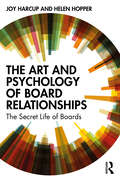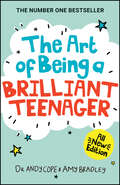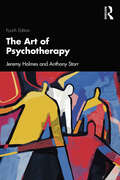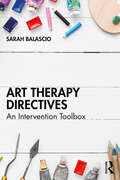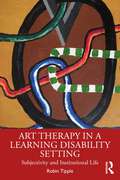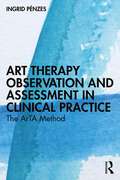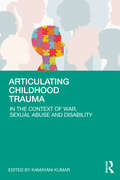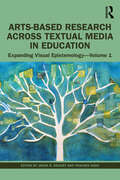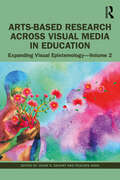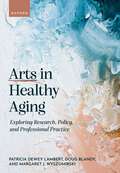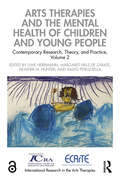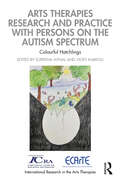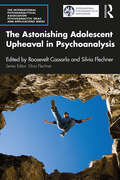- Table View
- List View
The Art and Psychology of Board Relationships: The Secret Life of Boards
by Joy Harcup Helen HopperThe relationships within boards can make or break an organisation, but well-functioning relationships take skill and effort to maintain. This book looks at the psychology behind individual and group behaviour and offers tactics and power tools to help make a success of your board career. The book shares advice and practical tips from 40 experienced board members from the worlds of corporates, the public sector and charities on how to spot and manage complex dynamics. And each chapter ends with techniques for unlocking tricky board relationships that you can put into practice immediately. The authors examine case studies and explore topics such as psychodynamics, cognitive behavioural psychology and neuroscience for insights into how boards react under pressure. They then demonstrate how to practise the ART of managing board relationships by increasing Awareness, Relating constructively to others, and choosing Tactics to ease tensions and foster collaboration. The Art and Psychology of Board Relationships: The Secret Life of Boards reveals why board relationships lie at the heart of organisational success – and how you can use them to gain competitive edge. It is essential reading for current and aspiring board members, coaches, facilitators and anyone with an interest in boardroom dynamics.
The Art and Psychology of Board Relationships: The Secret Life of Boards
by Joy Harcup Helen HopperThe relationships within boards can make or break an organisation, but well-functioning relationships take skill and effort to maintain. This book looks at the psychology behind individual and group behaviour and offers tactics and power tools to help make a success of your board career. The book shares advice and practical tips from 40 experienced board members from the worlds of corporates, the public sector and charities on how to spot and manage complex dynamics. And each chapter ends with techniques for unlocking tricky board relationships that you can put into practice immediately. The authors examine case studies and explore topics such as psychodynamics, cognitive behavioural psychology and neuroscience for insights into how boards react under pressure. They then demonstrate how to practise the ART of managing board relationships by increasing Awareness, Relating constructively to others, and choosing Tactics to ease tensions and foster collaboration. The Art and Psychology of Board Relationships: The Secret Life of Boards reveals why board relationships lie at the heart of organisational success – and how you can use them to gain competitive edge. It is essential reading for current and aspiring board members, coaches, facilitators and anyone with an interest in boardroom dynamics.
The Art of Being A Brilliant Teenager
by Andy Cope Amy BradleyThe BESTSELLING book on BEING A TEEN, now updated into an all new edition. In a world where there’s a lot of talk about ‘living your best life’ and being your ‘best self’, The Art of Being a Brilliant Teenager shows you how. The book has a strong academic underpinning (its DNA is taken from the author’s PhD) but is written in a fun and non-patronising way. The Art of Being a Brilliant Teenager is a book that prepares young people for REAL life; addressing modern issues of screen time and social media, as well as the teenage perennials of confidence, positivity, motivation and relationships. The book is built on a rock-solid foundation of wellbeing and human flourishing but is quirky in tone and entertaining to read. Dr Andy Cope’s words are brilliantly brought to life by award winning illustrator, Amy Bradley. The book includes activities and thought-provoking questions that encourage the user to interact with the material. Reflecting and journalling helps make the messages stick. Learn how to: Stay upbeat in a fast-paced world Be resilient and rise to life’s challenges Create strong relationships Conquer anxiety Tap into your values and use them to guide your life Shape your future The book has a deliberately light touch but is not light-weight. It doesn’t dodge the issues. In a world of rising anxiety, The Art of Being a Brilliant Teenager provides a personal upgrade to ‘world class’. It shows young people how to let go of bad habits and develop positive traits that will fire up their future. It covers themes of resilience, values, consumerism, purpose and communication, in a page-turning way. The Art of Being a Brilliant Teenager is THE go-to book to ease young people into adulthood.
The Art of Being A Brilliant Teenager
by Andy Cope Amy BradleyThe BESTSELLING book on BEING A TEEN, now updated into an all new edition. In a world where there’s a lot of talk about ‘living your best life’ and being your ‘best self’, The Art of Being a Brilliant Teenager shows you how. The book has a strong academic underpinning (its DNA is taken from the author’s PhD) but is written in a fun and non-patronising way. The Art of Being a Brilliant Teenager is a book that prepares young people for REAL life; addressing modern issues of screen time and social media, as well as the teenage perennials of confidence, positivity, motivation and relationships. The book is built on a rock-solid foundation of wellbeing and human flourishing but is quirky in tone and entertaining to read. Dr Andy Cope’s words are brilliantly brought to life by award winning illustrator, Amy Bradley. The book includes activities and thought-provoking questions that encourage the user to interact with the material. Reflecting and journalling helps make the messages stick. Learn how to: Stay upbeat in a fast-paced world Be resilient and rise to life’s challenges Create strong relationships Conquer anxiety Tap into your values and use them to guide your life Shape your future The book has a deliberately light touch but is not light-weight. It doesn’t dodge the issues. In a world of rising anxiety, The Art of Being a Brilliant Teenager provides a personal upgrade to ‘world class’. It shows young people how to let go of bad habits and develop positive traits that will fire up their future. It covers themes of resilience, values, consumerism, purpose and communication, in a page-turning way. The Art of Being a Brilliant Teenager is THE go-to book to ease young people into adulthood.
The Art of Psychotherapy
by Jeremy Holmes Anthony StorrStorr’s The Art of Psychotherapy first appeared in 1979 and became an instant classic. After Storr’s death, a third edition was rewritten and revised by Jeremy Holmes, and this fourth edition is a further up-to-date iteration. Storr (1920–2001) and Holmes, both medical psychoanalytic psychotherapists, are ‘elders’ in the world of psychotherapy. Their eclectic, experienced and cultured voices offer students and psychotherapy practitioners clinical wisdom hard to find elsewhere. Their book expounds in a very practical way the issues entailed in setting up and maintaining a psychotherapeutic relationship and practice: how to introduce oneself, arrange one’s consulting room, establish a contract, when and how to make ‘interpretations'. The second half of the book deals with more general and often problematic issues, including how to align therapy in the light of diagnosis, working with ‘difficult’ patients, therapy termination, and the life course of a therapist, ending with a valedictory overview. In this fourth edition, Holmes has added a chapter on the scientific validation of psychotherapy, sections on tele- and e-therapy, non-binary gender and sexual identities and the impact of race and class on the therapeutic relationship. This engaging, accessible and profound book is essential reading for psychotherapists, counsellors, psychiatrists and mental health practitioners in training or practice.
The Art of Psychotherapy
by Jeremy Holmes Anthony StorrStorr’s The Art of Psychotherapy first appeared in 1979 and became an instant classic. After Storr’s death, a third edition was rewritten and revised by Jeremy Holmes, and this fourth edition is a further up-to-date iteration. Storr (1920–2001) and Holmes, both medical psychoanalytic psychotherapists, are ‘elders’ in the world of psychotherapy. Their eclectic, experienced and cultured voices offer students and psychotherapy practitioners clinical wisdom hard to find elsewhere. Their book expounds in a very practical way the issues entailed in setting up and maintaining a psychotherapeutic relationship and practice: how to introduce oneself, arrange one’s consulting room, establish a contract, when and how to make ‘interpretations'. The second half of the book deals with more general and often problematic issues, including how to align therapy in the light of diagnosis, working with ‘difficult’ patients, therapy termination, and the life course of a therapist, ending with a valedictory overview. In this fourth edition, Holmes has added a chapter on the scientific validation of psychotherapy, sections on tele- and e-therapy, non-binary gender and sexual identities and the impact of race and class on the therapeutic relationship. This engaging, accessible and profound book is essential reading for psychotherapists, counsellors, psychiatrists and mental health practitioners in training or practice.
Art Therapy Directives: An Intervention Toolbox
by Sarah BalascioArt Therapy Directives: An Intervention Toolbox is an all-inclusive manual of art therapy directives designed to be a comprehensive and organized resource for art therapists and other trained mental health professionals. Art therapy directives are directions for creating art and often require use of specific art media, both of which are tailored to the client’s particular need. Using this book, art therapists will be able to search by population, themes, and art media to find just the right project for their session whether working with individuals or in groups. Comprised of a compilation from traditional art therapy directives, the author’s own experiences, and other published practices, a wide range of mental health topics are included such as depression, self-esteem, life transitions, and trauma. Special consideration is given to populations like adolescents, older adults, veterans, and the LGBTQ+ community. This manual is the answer that many in the field of art therapy have been missing for an all-encompassing, organized reference book to guide art therapy sessions with a wide variety of client populations..
Art Therapy Directives: An Intervention Toolbox
by Sarah BalascioArt Therapy Directives: An Intervention Toolbox is an all-inclusive manual of art therapy directives designed to be a comprehensive and organized resource for art therapists and other trained mental health professionals. Art therapy directives are directions for creating art and often require use of specific art media, both of which are tailored to the client’s particular need. Using this book, art therapists will be able to search by population, themes, and art media to find just the right project for their session whether working with individuals or in groups. Comprised of a compilation from traditional art therapy directives, the author’s own experiences, and other published practices, a wide range of mental health topics are included such as depression, self-esteem, life transitions, and trauma. Special consideration is given to populations like adolescents, older adults, veterans, and the LGBTQ+ community. This manual is the answer that many in the field of art therapy have been missing for an all-encompassing, organized reference book to guide art therapy sessions with a wide variety of client populations..
Art Therapy in a Learning Disability Setting: Subjectivity and Institutional Life
by Robin TippleThis book originates from the experience of providing Art Therapy for adults diagnosed with learning disabilities living in an institutional setting. It follows two longitudinal case studies in an attempt to understand dyadic relations in Art Therapy. Representing an important contribution to the history of Art Therapy, especially as it relates to the history of learning disabilities, this book explores past and contemporary discourses and contexts to identify a meaningful, thoughtful approach to the making and reading of images and the client/therapist relationship. It presents the thinking that informed the author’s practice at the time, from both the point of view of the time and its present moment, to contextualize contemporary Art Therapy practice. Through the storytelling of long-term Art Therapy cases with thoughtful investigation, the author explores themes of melancholia, abjection, and alienation, while also creating a depth to current practice. The chapters are richly illustrated, the two case studies are personal and compelling, and the writing is accessible to all readers. The book will appeal to practicing and training therapists of all persuasions, but especially those in Art Therapy or learning disability fields that have an interest in the visual forms of imagining and communicating.
Art Therapy in a Learning Disability Setting: Subjectivity and Institutional Life
by Robin TippleThis book originates from the experience of providing Art Therapy for adults diagnosed with learning disabilities living in an institutional setting. It follows two longitudinal case studies in an attempt to understand dyadic relations in Art Therapy. Representing an important contribution to the history of Art Therapy, especially as it relates to the history of learning disabilities, this book explores past and contemporary discourses and contexts to identify a meaningful, thoughtful approach to the making and reading of images and the client/therapist relationship. It presents the thinking that informed the author’s practice at the time, from both the point of view of the time and its present moment, to contextualize contemporary Art Therapy practice. Through the storytelling of long-term Art Therapy cases with thoughtful investigation, the author explores themes of melancholia, abjection, and alienation, while also creating a depth to current practice. The chapters are richly illustrated, the two case studies are personal and compelling, and the writing is accessible to all readers. The book will appeal to practicing and training therapists of all persuasions, but especially those in Art Therapy or learning disability fields that have an interest in the visual forms of imagining and communicating.
Art Therapy Observation and Assessment in Clinical Practice: The ArTA Method
by Ingrid PénzesThis book describes ArTA, an evidence-based method for art therapy observation and assessment. This novel method argues the art-making process and art product are related to aspects of mental health. The results of the author’s own research show that observed patterns in material interaction, material experience, and the specific combinations of formal elements of the art product reveal the client’s balance between thinking and feeling, and adaptability. Divided into four sections, the book illustrates this research, theory, and application of the ArTA method using examples and case histories with clear frameworks that give guidance in art therapy observation and assessment. It provides direction for formulating treatment goals and drawing up appropriate treatment interventions. Intended for art therapy students and practicing art therapists, this methodology will challenge readers to rethink the relationship between a client’s interaction with art materials and their mental health.
Art Therapy Observation and Assessment in Clinical Practice: The ArTA Method
by Ingrid PénzesThis book describes ArTA, an evidence-based method for art therapy observation and assessment. This novel method argues the art-making process and art product are related to aspects of mental health. The results of the author’s own research show that observed patterns in material interaction, material experience, and the specific combinations of formal elements of the art product reveal the client’s balance between thinking and feeling, and adaptability. Divided into four sections, the book illustrates this research, theory, and application of the ArTA method using examples and case histories with clear frameworks that give guidance in art therapy observation and assessment. It provides direction for formulating treatment goals and drawing up appropriate treatment interventions. Intended for art therapy students and practicing art therapists, this methodology will challenge readers to rethink the relationship between a client’s interaction with art materials and their mental health.
Articulating Childhood Trauma: In the Context of War, Sexual Abuse and Disability
The volume addresses the pertinent need to examine childhood trauma revolving around themes of war, sexual abuse, and disability. Drawing narratives from spatial, temporal, and cultural contexts, the book analyses how conflict, abuse, domestic violence, contours of gender construction, and narratives of ableism affect a child’s transactions with society. While exploring complex manifestations of children’s experience of trauma, the volume seeks to understand the issues related to translatability/representation, of trauma bearing in mind the fact that children often lack the language to express their sense of loss. The book in its study of childhood trauma does a close exegesis of select literary pieces, drawings done by children, memoirs, and graphic narratives.Academicians and research scholars from the disciplines of childhood studies, trauma studies, resilience studies, visual studies, gender studies, cultural studies, disability studies, and film studies stand to benefit from this volume. The ideas that have been expressed in this volume will richly contribute towards further research and scholarship in this domain.
Articulating Childhood Trauma: In the Context of War, Sexual Abuse and Disability
by Kamayani KumarThe volume addresses the pertinent need to examine childhood trauma revolving around themes of war, sexual abuse, and disability. Drawing narratives from spatial, temporal, and cultural contexts, the book analyses how conflict, abuse, domestic violence, contours of gender construction, and narratives of ableism affect a child’s transactions with society. While exploring complex manifestations of children’s experience of trauma, the volume seeks to understand the issues related to translatability/representation, of trauma bearing in mind the fact that children often lack the language to express their sense of loss. The book in its study of childhood trauma does a close exegesis of select literary pieces, drawings done by children, memoirs, and graphic narratives.Academicians and research scholars from the disciplines of childhood studies, trauma studies, resilience studies, visual studies, gender studies, cultural studies, disability studies, and film studies stand to benefit from this volume. The ideas that have been expressed in this volume will richly contribute towards further research and scholarship in this domain.
Arts-Based Research Across Textual Media in Education: Expanding Visual Epistemology - Volume 1
In company with its sister volume, Arts-Based Research Across Textual Media in Education explores arts-based approaches to research across media, including film and comics-related material, from a variety of geographic locations and across a range of subdisciplines within the field of education. This first volume takes a textual focus, capturing process, poetic, and dramaturgical approaches. The authors aim to highlight some of the approaches that are not always centered in arts-based research. The contributors represent a variety of arts-based practices and methods, and they weave this marrying of artistic and scientific expertise and experience into the fabric of the chapters themselves. Authors from international contexts speak to the importance of utilizing artistic approaches for research processes. From multimodal field notes to poetic forms to the dramaturgical, chapters in this book represent steps forward in educational inquiry to bringing together both the creative and credible. The book includes multiple images and rich descriptions shared from the field. This first volume covers amongst other topics: co-created narratives, creative fiction in research, analytic portraits, dramatic representation, and critical poetic inquiry. It would be suitable for graduate students and scholars interested in qualitative inquiry and arts-based methods, in education and the social sciences.
Arts-Based Research Across Textual Media in Education: Expanding Visual Epistemology - Volume 1
by Jason D. DeHart Peaches HashIn company with its sister volume, Arts-Based Research Across Textual Media in Education explores arts-based approaches to research across media, including film and comics-related material, from a variety of geographic locations and across a range of subdisciplines within the field of education. This first volume takes a textual focus, capturing process, poetic, and dramaturgical approaches. The authors aim to highlight some of the approaches that are not always centered in arts-based research. The contributors represent a variety of arts-based practices and methods, and they weave this marrying of artistic and scientific expertise and experience into the fabric of the chapters themselves. Authors from international contexts speak to the importance of utilizing artistic approaches for research processes. From multimodal field notes to poetic forms to the dramaturgical, chapters in this book represent steps forward in educational inquiry to bringing together both the creative and credible. The book includes multiple images and rich descriptions shared from the field. This first volume covers amongst other topics: co-created narratives, creative fiction in research, analytic portraits, dramatic representation, and critical poetic inquiry. It would be suitable for graduate students and scholars interested in qualitative inquiry and arts-based methods, in education and the social sciences.
Arts-Based Research Across Visual Media in Education: Expanding Visual Epistemology - Volume 2
In company with its sister volume, this book explores arts-based approaches to research across media, including film and comics-related material, from a variety of geographic locations and across a range of subdisciplines within the field of education. This second volume has a focus exclusively on visual output and image-based research and methods. The book aims to highlight some of the approaches that are not always centered in arts-based research. The visual takes center stage as authors lead with comics-based representations, among other forms of arts-based inquiry. These chapters follow on from the first collection and serve to expand thinking about merging creative methods with analysis and exploration in the world of education. From mixtapes to the curatorial, these chapters showcase the ways in which scholars explore the multitude of human experiences. This second volume covers, among other topics: comics in qualitative research, visual journaling, multimodal fieldnotes and discourse, and creative visual outputs. It is suitable reading for graduate students and scholars interested in qualitative inquiry and arts-based methods, in education and the social sciences.
Arts-Based Research Across Visual Media in Education: Expanding Visual Epistemology - Volume 2
by Jason DeHart Peaches HashIn company with its sister volume, this book explores arts-based approaches to research across media, including film and comics-related material, from a variety of geographic locations and across a range of subdisciplines within the field of education. This second volume has a focus exclusively on visual output and image-based research and methods. The book aims to highlight some of the approaches that are not always centered in arts-based research. The visual takes center stage as authors lead with comics-based representations, among other forms of arts-based inquiry. These chapters follow on from the first collection and serve to expand thinking about merging creative methods with analysis and exploration in the world of education. From mixtapes to the curatorial, these chapters showcase the ways in which scholars explore the multitude of human experiences. This second volume covers, among other topics: comics in qualitative research, visual journaling, multimodal fieldnotes and discourse, and creative visual outputs. It is suitable reading for graduate students and scholars interested in qualitative inquiry and arts-based methods, in education and the social sciences.
Arts in Healthy Aging: Exploring Research, Policy, and Professional Practice
by Patricia Dewey Lambert Doug Blandy Margaret WyszomirskiArts in Healthy Aging examines public policies and professional practices that effectively use the arts to support health and well-being outcomes in older adults. It offers a comprehensive study of why and how purposefully-designed programs that engage the visual, performing, and literary arts can support the health and well-being of older adults. The authors argue that it is the right time for the American arts and aging movement to restructure itself as a national network and advocacy coalition across four domains: the arts, health, aging, and lifelong learning. Building on decades of published research, government documents, and program models, this scholarly volume provides historical perspectives, new theoretical approaches, analytical models, resources for researchers and practitioners, and pathways forward for advancing the interdisciplinary arts in healthy aging field of scholarship and practice. Although focused on the United States, the discussion of policies and practices is relevant and applicable to other countries as appropriate to their specific contexts.
Arts Therapies and the Mental Health of Children and Young People: Contemporary Research, Theory, and Practice, Volume 2 (ISSN)
by Uwe Herrmann Margaret Hills De Zárate Heather M. Hunter Salvo PitruzzellaThis second volume expands and develops the discussion on arts therapies begun in volume one on the field’s relationship with children and young people’s mental health, demonstrating further contemporary research within international contexts.The book responds to a resounding call to address children and young people’s mental health. It explores a unique mix of diverse arts modalities including art, music, dance, expressive arts, and drama, creating opportunities for discourse and discussion of how the different arts therapies cohere and relate to each other. Chapters are truly global in approach, ranging from schools in India to children’s hospices in the United Kingdom, refugee transit camps in Greece, and residential care programmes for LGBTQ+ youth in the United States. Discussions from Greece and Taiwan, and innovative research from Israel, Norway, and Scotland are also featured with reference to diverse social, political, and cultural contexts. Ultimately, chapters prioritise the links between research, theory, and practice, providing accessible and implication-led dialogue on contemporary issues.This book provides new insights into the expanding field of the arts therapies and will be of great interest to arts therapists as well as academics and students in the fields of arts therapies, social work, psychotherapy, health psychology, and education.
Arts Therapies and the Mental Health of Children and Young People: Contemporary Research, Theory, and Practice, Volume 2 (ISSN)
by Uwe Herrmann de Zárate, Margaret Hills Heather M. Hunter Salvo PitruzzellaThis second volume expands and develops the discussion on arts therapies begun in volume one on the field’s relationship with children and young people’s mental health, demonstrating further contemporary research within international contexts.The book responds to a resounding call to address children and young people’s mental health. It explores a unique mix of diverse arts modalities including art, music, dance, expressive arts, and drama, creating opportunities for discourse and discussion of how the different arts therapies cohere and relate to each other. Chapters are truly global in approach, ranging from schools in India to children’s hospices in the United Kingdom, refugee transit camps in Greece, and residential care programmes for LGBTQ+ youth in the United States. Discussions from Greece and Taiwan, and innovative research from Israel, Norway, and Scotland are also featured with reference to diverse social, political, and cultural contexts. Ultimately, chapters prioritise the links between research, theory, and practice, providing accessible and implication-led dialogue on contemporary issues.This book provides new insights into the expanding field of the arts therapies and will be of great interest to arts therapists as well as academics and students in the fields of arts therapies, social work, psychotherapy, health psychology, and education.
Arts Therapies Research and Practice with Persons on the Autism Spectrum: Colourful Hatchlings (International Research in the Arts Therapies)
by Supritha Aithal Vicky KarkouThis volume presents cutting-edge research and practice on Creative Arts Therapies or Arts Therapies for individuals on the autism spectrum of all ages, outlining the development of effective and accessible approaches to support the diverse needs of this client group. Consisting of 14 research-based chapters with contributions from over 30 authors from across the world, the book brings together research from art, music, drama, dance, movement and other forms of art therapies. The book demonstrates how arts therapies have evolved over the years to address the health and social care needs of people on the autism spectrum and their caregivers. Chapters explore the implications of arts therapies across a spectrum of needs in various settings and offer a comprehensive picture including a variety of research outcomes and therapeutic processes, and critiques both of existing practice and research methodologies. The book will be key reading for researchers, scholars and clinicians from dance movement therapy, music therapy, art therapy, dramatherapy and expressive arts therapies. It will also be of interest to post-graduate students and mental health professionals working with children, adults and families of individuals on the autism spectrum.
Arts Therapies Research and Practice with Persons on the Autism Spectrum: Colourful Hatchlings (International Research in the Arts Therapies)
by Supritha Aithal Vicky KarkouThis volume presents cutting-edge research and practice on Creative Arts Therapies or Arts Therapies for individuals on the autism spectrum of all ages, outlining the development of effective and accessible approaches to support the diverse needs of this client group. Consisting of 14 research-based chapters with contributions from over 30 authors from across the world, the book brings together research from art, music, drama, dance, movement and other forms of art therapies. The book demonstrates how arts therapies have evolved over the years to address the health and social care needs of people on the autism spectrum and their caregivers. Chapters explore the implications of arts therapies across a spectrum of needs in various settings and offer a comprehensive picture including a variety of research outcomes and therapeutic processes, and critiques both of existing practice and research methodologies. The book will be key reading for researchers, scholars and clinicians from dance movement therapy, music therapy, art therapy, dramatherapy and expressive arts therapies. It will also be of interest to post-graduate students and mental health professionals working with children, adults and families of individuals on the autism spectrum.
The Astonishing Adolescent Upheaval in Psychoanalysis (The International Psychoanalytical Association Psychoanalytic Ideas and Applications Series)
This book brings together international contributors to share insight from their theoretical and clinical work with adolescents, considering the different psychopathological responses they see in adolescent patients and how these can be worked with in analysis.Each chapter addresses a specific topic, focusing on representing the clinical realities facing psychoanalysts in treating adolescents with different types of disturbances at the psychic level. They cover a range of situations and perspectives, including discussion of maternal violence, the erotic field, self-mutilation, and social withdrawal, with a core focus on issues affecting contemporary adolescents. Bringing together a vast range of experience, The Astonishing Adolescent Upheaval in Psychoanalysis presents a new approach which re-establishes the impact of the responses of significant objects in the impasses present in narcissistic suffering. This book will be of great interest to all psychoanalytic and psychodynamic clinicians working with adolescents.
The Astonishing Adolescent Upheaval in Psychoanalysis (The International Psychoanalytical Association Psychoanalytic Ideas and Applications Series)
by Roosevelt Cassorla Silvia FlechnerThis book brings together international contributors to share insight from their theoretical and clinical work with adolescents, considering the different psychopathological responses they see in adolescent patients and how these can be worked with in analysis.Each chapter addresses a specific topic, focusing on representing the clinical realities facing psychoanalysts in treating adolescents with different types of disturbances at the psychic level. They cover a range of situations and perspectives, including discussion of maternal violence, the erotic field, self-mutilation, and social withdrawal, with a core focus on issues affecting contemporary adolescents. Bringing together a vast range of experience, The Astonishing Adolescent Upheaval in Psychoanalysis presents a new approach which re-establishes the impact of the responses of significant objects in the impasses present in narcissistic suffering. This book will be of great interest to all psychoanalytic and psychodynamic clinicians working with adolescents.
